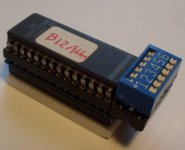giobbi
Veteran Member
[[ Hi Mike! How are you? ]]
In this article you can find both RAM and ROM adapter especially made for PET 2001/8; also a Video RAM adapter, just in case you run out of RAM chips.
http://www.8bit-homecomputermuseum.at/repair/bluepet/bluepet.html
In this article you can find both RAM and ROM adapter especially made for PET 2001/8; also a Video RAM adapter, just in case you run out of RAM chips.
http://www.8bit-homecomputermuseum.at/repair/bluepet/bluepet.html

